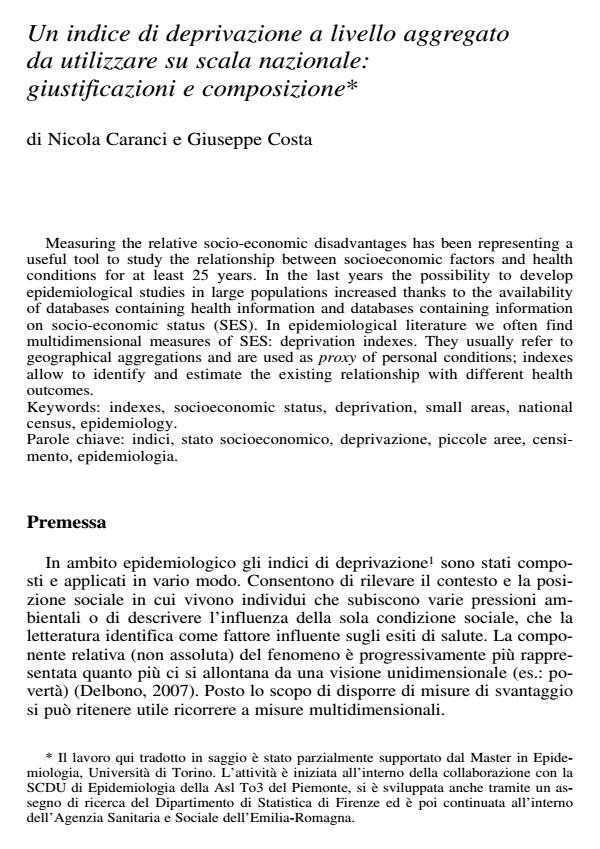Un indice di deprivazione a livello aggregato da utilizzare su scala nazionale: giustificazioni e composizione
Journal title SALUTE E SOCIETÀ
Author/s Giuseppe Costa, Nicola Caranci
Publishing Year 2009 Issue 2009/1
Language Italian Pages 21 P. 58-78 File size 90 KB
DOI 10.3280/SES2009-001006
DOI is like a bar code for intellectual property: to have more infomation
click here
Below, you can see the article first page
If you want to buy this article in PDF format, you can do it, following the instructions to buy download credits

FrancoAngeli is member of Publishers International Linking Association, Inc (PILA), a not-for-profit association which run the CrossRef service enabling links to and from online scholarly content.
Un indice di deprivazione a livello aggregato da utilizzare su scala nazionale: giustificazioni e composizione - Measuring the relative socio-economic disadvantages has been representing a useful tool to study the relationship between socioeconomic factors and health conditions for at least 25 years. In the last years the possibility to develop epidemiological studies in large populations increased thanks to the availability of databases containing health information and databases containing information on socio-economic status (SES). In epidemiological literature we often find multidimensional measures of SES: deprivation indexes. They usually refer to geographical aggregations and are used as proxy of personal conditions; indexes allow to identify and estimate the existing relationship with different health outcomes. Keywords: indexes, socioeconomic status, deprivation, small areas, national census, epidemiology. Parole chiave: indici, stato socioeconomico, deprivazione, piccole aree, censimento, epidemiologia.
- Exploring gender differences in medication consumption and mortality in a cohort of hypertensive patients in Northern Italy David Consolazio, Maria Elena Gattoni, Antonio Giampiero Russo, in BMC Public Health 768/2022
DOI: 10.1186/s12889-022-13052-9 - Statistical Methods for Spatial Planning and Monitoring Massimo Bilancia, Giusi Graziano, Giacomo Demarinis, pp.1 (ISBN:978-88-470-2750-3)
- Italian Deprivation Index and Dental Caries in 12-Year-Old Children: A Multilevel Bayesian Analysis Domenica Matranga, Guglielmo Campus, Paolo Castiglia, Laura Strohmenger, Giuliana Solinas, in Caries Research /2014 pp.584
DOI: 10.1159/000358810 - Development of a cross-cultural deprivation index in five European countries Elodie Guillaume, Carole Pornet, Olivier Dejardin, Ludivine Launay, Roberto Lillini, Marina Vercelli, Marc Marí-Dell'Olmo, Amanda Fernández Fontelo, Carme Borrell, Ana Isabel Ribeiro, Maria Fatima de Pina, Alexandra Mayer, Cyrille Delpierre, Bernard Rachet, Guy Launoy, in Journal of Epidemiology and Community Health /2016 pp.493
DOI: 10.1136/jech-2015-205729 - Incorporating Environmental Justice into Second Generation Indices of Multiple Deprivation: Lessons from the UK and Progress Internationally Jon Fairburn, Werner Maier, Matthias Braubach, in International Journal of Environmental Research and Public Health /2016 pp.750
DOI: 10.3390/ijerph13080750 - Balancing harms and benefits of service mammography screening programs: a cohort study Donella Puliti, Guido Miccinesi, Marco Zappa, Gianfranco Manneschi, Emanuele Crocetti, Eugenio Paci, in Breast Cancer Research R9/2012
DOI: 10.1186/bcr3090 - The Impact of Mental Health Comorbidities on Unplanned Admissions for Physical Conditions: A Retrospective Observational Analysis Fabrizio Cedrone, Omar Enzo Santangelo, Vittorio Di Michele, Alessandro Catalini, Flavia Pennisi, Lorenzo Stacchini, Marco Fonzo, Vincenzo Montagna, Vincenza Gianfredi, Giuseppe Di Martino, in Healthcare /2025 pp.827
DOI: 10.3390/healthcare13070827
Giuseppe Costa, Nicola Caranci, Un indice di deprivazione a livello aggregato da utilizzare su scala nazionale: giustificazioni e composizione in "SALUTE E SOCIETÀ" 1/2009, pp 58-78, DOI: 10.3280/SES2009-001006